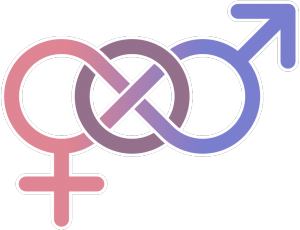Same-sex marriage is the law of the land! Thank you #SCOTUS! Yet academics and pundits alike caution LGBTQ Americans that marriage equality will not leave us with a “post-gay” society. Instead, the new state of affairs requires that we simultaneously acknowledge the correlation between marriage equality and a growing social acceptance of LGBTQ individuals and that our community is made up of people who, for practical or ideological reasons, will not benefit in the same way as the mainstream LGBTQ population will from marriage equality. 
Who are such people? One group includes bisexual Americans, who to many appear invisible, especially since 84% of those in relationships are in a relationship with an individual of the opposite gender. A review of social research shows us just why we should take care to address bisexuals’ concerns in our community. Even though bisexual people do not necessarily present as queer, sexual orientation is a defining feature of close relationships in which an individual is bisexual. Biphobia and stereotyping are central to relationship challenges.
Biphobia is a direct cause of the low numbers (28%) of “out” bisexuals. A recent study shows that respondents’ understanding of the prevalence of biphobia and monosexism plays a direct role in bisexual peoples’ reluctance to come out. Additionally, bisexual-identified people face the same heterosexism and homophobia that are faced by the rest of the LGBTQ community. Unlike gays and lesbians, due to their perceived ability to fall in love with and commit to someone of the opposite sex, bisexuals must often deal with the lingering hopes of family members that they will eventually conform to a monogamous heterosexual marriage.
A major source of conflict within relationships in which one member is bisexual is the disjuncture between assumptions about bisexuals and the variety of ways that bisexuals engage in relationships. Heather L. Armstrong and Elke D. Reissing reported that bisexual stereotypes alone worked to cause relational issues that worsened as commitment levels increased. Common issues included jealousy, competition between (in many cases imagined) potential lovers, and rigid expectations of specific behavior, including (but not limited to) monogamy, non-monogamy, sexual adventurousness, and constrained sexuality. It was not the behaviors of the bisexual partner that caused any of these disruptions, but rather it was the non-bisexual partner’s expectation of instability and reliance on stereotypes that was the catalyst for relationship trouble.
Some bisexuals do fulfill stereotypes. But even these are a function more of a bisexual individual’s response to biphobia than to anything inherently pathological about a bisexual person. In a study of straight-identified women who had secondary same-sex sexual relations in secrecy, a researcher found that they did so because they felt that it was the only way to reconcile their same-sex sexual desires and their commitment to their marriage and family. In other words, they engaged in these behaviors in secrecy in order to maintain their long-term relationships.
Bisexual individuals, especially those with opposite-sex partners, were significantly more likely than lesbian, gay, and heterosexual individuals to be victims of intimate partner violence. Bisexual women had the highest rates of all forms of victimization, and bisexual men were significantly more likely than gay and straight men to experience IPV. Bisexuals overwhelmingly (78.5 percent of men and 89.5 percent of women) endured this violence in a mixed-sex relationship. A qualitative study investigated physical and psychological IPV against bisexuals, and found that in many cases, the violence was motivated by biphobia.
Despite the burden of biphobia, there is still much potential for bisexual people to engage in satisfying relationships. Researchers have demonstrated how a reduction in gender binaries and heteronormative expectations in relationships leads to success. A novel study on relationship satisfaction surveyed 26 mixed-sex couples in which at least one partner was openly bisexual and neither partner was in counseling. Half of these couples had a member who engaged in sex outside the primary relationship. These couples had largely satisfactory relationships, and this was irrespective of “income, education, time of disclosure, sexual activity, and communication levels.” The author remarked that the findings signified the importance of “compassion, commitment, love, and understanding” to satisfactory relationships in which one member is bisexual.
Again and again the research shows that when bisexuals do not feel stigmatized, judged, or constrained by their bisexual identities, they have much greater promise for satisfying, stable relationships. As the LGBTQ community rallies around mainstream goals, it will be important to remember that our work will not be complete until LGBTQ status does not increase the likelihood of negative outcomes for the public or personal lives of any members within our community.
This spring, Braxton Jones completed his BA in sociology at Framingham State University, where he served as a CCF Intern. He begins a graduate degree in sociology at University of New Hampshire in the fall, and he serves as a CCF Graduate Research and Public Affairs Scholar.

Comments 2
Ask a Bisexual: “Can Men and Women Ever Just Be Friends?” | The Lobster Dance — July 17, 2015
[…] are the reasons why bisexuals are more likely than monosexuals to have poor mental health, are at higher risk of intimate partner violence–particularly violence based in biphobia, and suffer from poor physical […]
Gender Reader: Bi Visibility (Sept. 2015) | The Lobster Dance — September 19, 2015
[…] Jones. “LGBTQ pride, yes! …how are bisexual couples faring?” The Society Pages. 1 July […]